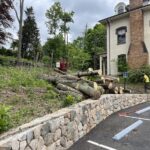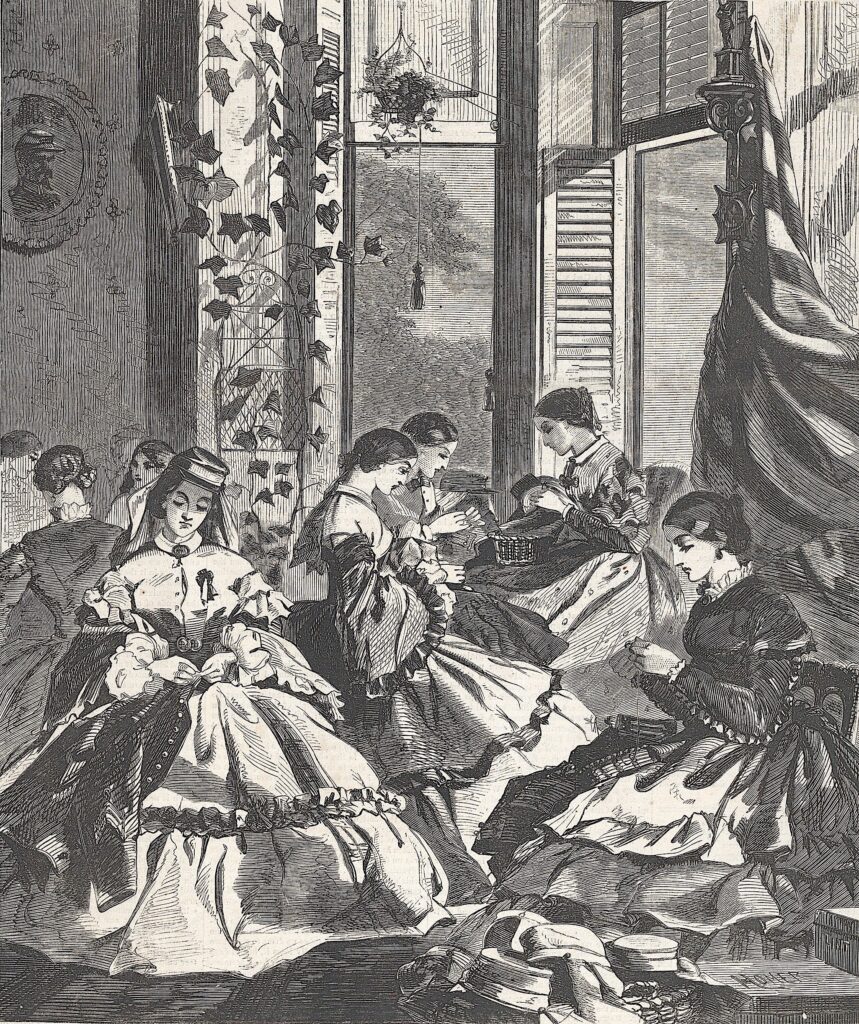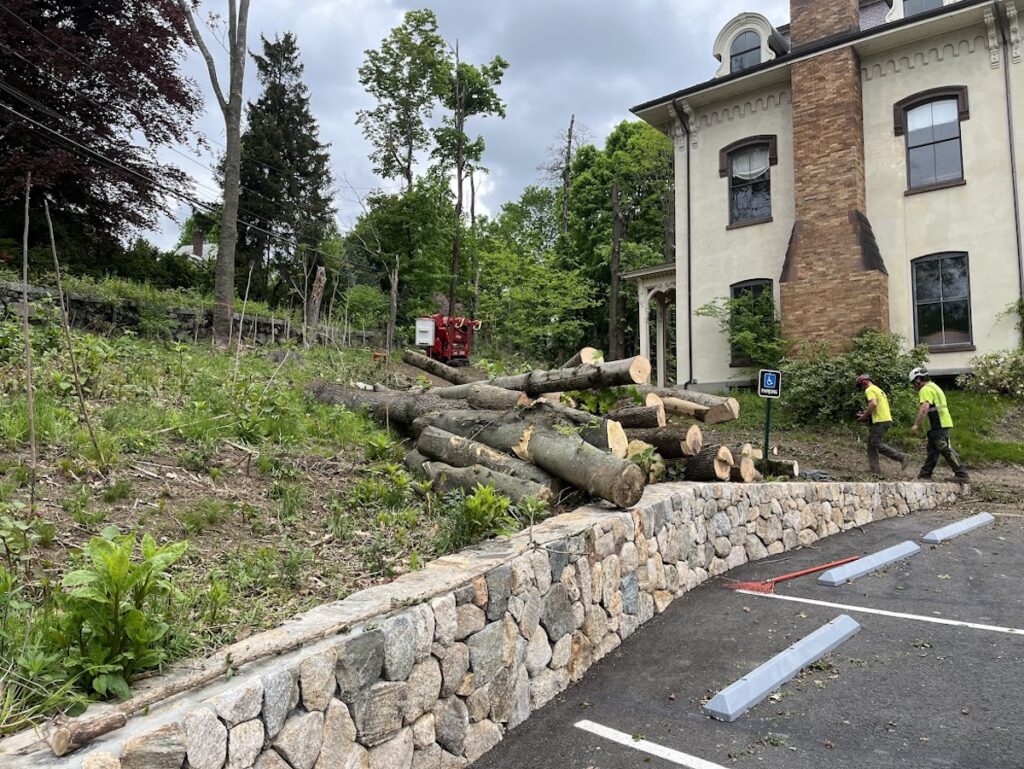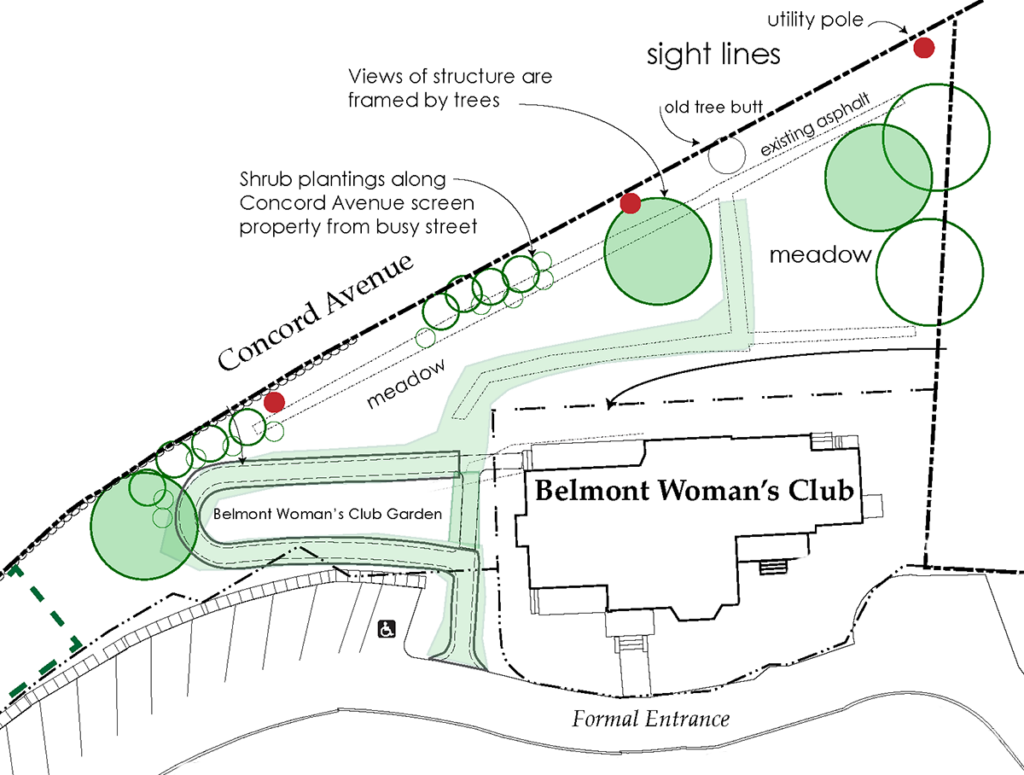
By Wendy Murphy and Neal Winston
Driving down Concord Avenue from Belmont Hill into town, you can’t help but notice the emergence of a stately Victorian mansion. A wall of trees hiding the mansion was removed this spring as part of a landscape restoration project for the back and side yards of the 1853 William Flagg Homer House at 661 Pleasant Street. The Belmont Woman’s Club owns the house and land. The project was sponsored and managed by the Belmont Land Trust, a volunteer nonprofit organization, which has held a conservation restriction on the property since 2010.
Long neglected, the Homer House backyard had become overgrown with invasive trees, shrubs, and weeds, shielding the back of the home that mirrors the beautiful architecture on the front of the house visible from Pleasant Street. With the help of Community Preservation Act funds, the Belmont Woman’s Club commissioned an assessment of the Homer House several years ago to determine what repairs were needed to restore the property to its original beauty.
Key projects were undertaken to replace the driveway and install parking spots, restore the grand cupola, and repair and restore all the windows to make them functional and safe. The most recent project entails repainting the exterior to its original historically correct colors, and repairing decks, railings, and other exterior wooden features of the house that have not been addressed since the property was built.
The backyard restoration plan has specific guidelines: it must meet the limitations of the conservation restriction, be true to the historic and period architecture of the house, and also support contemporary conservation management techniques, including keeping or introducing only native plant species and trees that would also support local suburban wildlife. Landscape architect Margaret Nestler of Nestler Land Design in Harvard, Massachusetts, who drafted the original landscape study when the conservation restriction was created, returned to create a landscape plan that includes these requirements. The plan also includes an allowance for an accessible pathway from the parking area into the house, a modern and necessary adaptation.
The yard was overrun with Norway maples, Japanese knotweed, mugwort, garlic mustard, burdock, Tree of Heaven, pokeweed, poison ivy, and other undesirable or invasive plants. The Land Trust hired Parterre Ecological, a firm that has worked on other Belmont projects and specializes in property restoration involving invasives. Parterre began this multiyear project with tree cutting and progressed to treating and removing invasive plants. A biodegradable erosion blanket was laid down, and plugs of rattlesnake master; Monarda species, narrow leaf mountain mint; and blue flag iris were planted. Unfortunately, the months-long drought this year slowed growth and further planting, but replanting will continue in the spring.
The next steps in the restoration plan for the backyard require stump grinding, renewed planting of field grasses and other plants, and replacement of native trees. The current trees include sugar maple, yellowwood, catalpa, and oaks. Care must be taken to plant new trees to visually frame the house as they mature to keep open sight lines from the street.
A fieldstone wall along the length of Concord Avenue topped with cut granite will eventually need to be restored. The front yard embankment also suffered from the reconstruction of the driveway and parking area, and after debris removal and topsoil replacement, lawn grass will be replanted next spring. Continuing invasive plant removal and treatment can take several years, particularly the knotweed.
Jean Devine, a Belmont resident and founder of Biodiversity Builders, a youth education program that provides summer internships in removing invasive species and replacing them with native plants, has introduced an interesting concept to the Land Trust called a Miyawaki Forest for the lower quadrant of the backyard closest to the intersection of Concord Avenue and Pleasant Street. Named after Japanese ecologist Akira Miyawaki, it is a pocket-sized densely grown “forest” of native trees sometimes only 40 feet by 20 feet or so in size. It is designed for tight urban and suburban areas, where it supports the environment, including birds and small wild animals.
The Belmont Land Trust, a volunteer nonprofit organization, has owned a conservation restriction on the .9-acre area surrounding the house since 2010. A conservation restriction is a permanent titled grant of development rights on a property in which the granting owner has a strong conservation preservation interest to see that it is never further developed. The land trust has the duty to oversee that the original owner and successor owners maintain the property under the terms of the restriction. The land trust has similar restrictions on about 24 acres of other properties around town.
The Belmont Land Trust has expended over $40,000 of its own funds on the project this past year, and it is expected that over the next several years, the total cost could run much higher. In cooperation with the Belmont Woman’s Club, the land trust is planning to begin fundraising in January to develop an endowment fund for the continued construction and perpetual care of the grounds. If you are interested in hearing more about the landscaping project as it continues, participating in the fundraising, or being invited to our meetings at the Homer House, email us at BLT@belmontlandtrust.org.
The steadfast preservation of the property to date by the Belmont Woman’s Club has its own interesting history, with a recent critical twist. When the Woman’s Club purchased the Homer House in 1927, it did so not only because it needed a big house to accommodate its hundreds of members but also because it wanted to save the beautiful mansion from destruction. A developer had purchased the property for $25,000 and had plans to tear it down and build seven houses on the land. Once the center of activity for high society, the house was last owned by a woman with no heirs, and times were tough, so the mansion market wasn’t hot.
The beautiful house on the hill was too important to tear down. It had been built by the wealthy Boston merchant William Flagg Homer. Uncle to famed American artist Winslow Homer, William Flagg spared no expense and designed a property that made national headlines for its architecture and style. Winslow Homer painted many pieces at the Homer House. His “croquet paintings” depict men and women playing croquet on the front lawn under massive European Beech trees, and his well-known War: Women Making Havelocks For The Volunteers shows women in the front parlor at the Homer House sewing hats for the Union soldiers during the Civil War. Winslow’s parents lived nearby, but he spent most of his time at his uncle’s house.
The Woman’s Club knew it was important to save the Homer House. Along with thousands of women’s clubs across the country, they were celebrating the 19th Amendment to the US Constitution, which granted women the right to vote. They needed a space where they could work together on women’s issues. The Homer House was ideal. They conspired with town officials and pooled their money to purchase the property away from the developer. They quickly added electricity and began hosting educational and civic events and organizing community service activities to support those in need.
Over the years, it had become more costly to maintain and preserve the property, particularly the upkeep on the ornate exterior, to heat, and to insure it. By 2008 or so, there was talk among some members that they might be better off just selling the property and moving to a modern and easier-to-maintain building. Yet other members never wavered in their commitment to their forebears to hold and preserve the Homer House from potential development as an historic piece of Belmont.
Despite the Homer House being in the highly restricted Belmont Historic District, they knew that once a developer bought the property, there would always be the potential for it to be destroyed. These members garnered a large majority of members to place the land around the house in a conservation restriction held by the Belmont Land Trust, ending any possible sale value to a developer. Thus the Homer House endures, and the Woman’s Club and the Land Trust stand together in their commitment to protect and preserve Belmont’s history for future generations.
Once a private organization open only to women, the Belmont Woman’s Club is now a nonprofit charitable organization open to all and is eager to welcome new members—including men—who want to help preserve this important part of Belmont’s history. Find out more at belmontwomansclub.com.

Winslow Homer’s War: Women Making Havelocks For The Volunteers. Source: http://www.metmuseum.org/art/collection/search/348790
Wendy Murphy is president of the Belmont Woman’s Club.
Neal Winston is president of the Belmont Land Trust.




Sorry, the comment form is closed at this time.